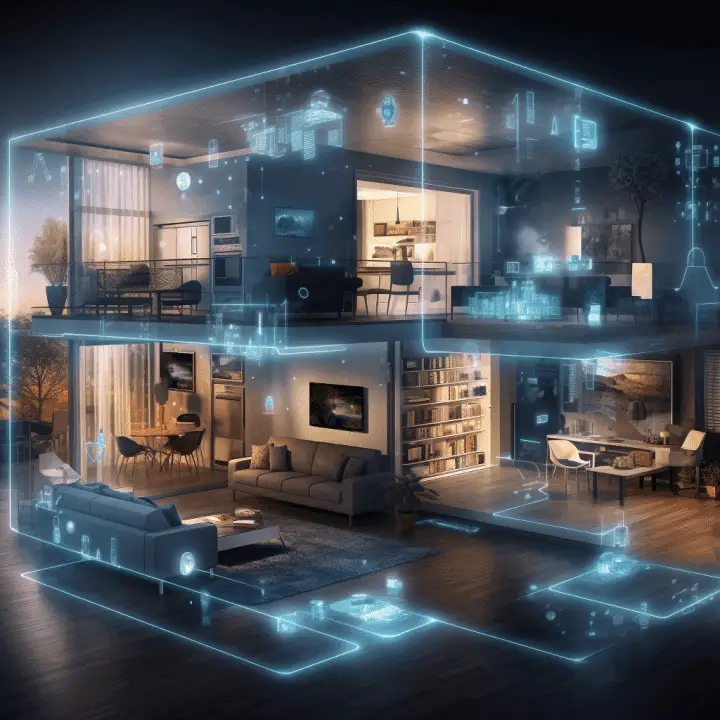- February 13, 2025
AI-Powered Smart Home Devices 2025: The Future of Living is Here

Introduction
Imagine waking up to a home that brews your coffee, adjusts the thermostat, and plays your favorite playlist—all before you open your eyes. By 2025, AI-powered smart home devices will make this a reality. From self-learning thermostats to voice-activated kitchen gadgets, the future of living is smarter, faster, and more intuitive. In this blog, we explore the cutting-edge AI innovations set to dominate 2025 and how they’ll redefine convenience, security, and energy efficiency.
Top 5 AI-Powered Smart Home Devices for 2025
- Adaptive Climate Control Systems
- Features:
- Learns your schedule and adjusts temperatures room-by-room.
- Integrates with weather forecasts to optimize energy use.
- Voice commands via ChatGPT-powered assistants.
- Brands to Watch: Nest 2025, Ecobee AI Series.
- Features:
- AI-Driven Security Cameras
- Features:
- Facial recognition for family vs. strangers.
- Real-time threat alerts (e.g., unattended packages).
- Solar-powered with 24/7 cloud backup.
- Brands to Watch: Ring AI Pro, Arlo VisionX.
- Features:
- Self-Cleaning Kitchens
- Features:
- Smart fridges that track expiry dates and auto-order groceries.
- Ovens that adjust cooking temps based on food weight.
- Floor-mopping robots with spill detection.
- Brands to Watch: Samsung AI Kitchen Hub, LG Smart Chef.
- Features:
- Health-Monitoring Mirrors
- Features:
- Scans skin for hydration levels and UV damage.
- Tracks posture and suggests ergonomic fixes.
- Syncs with wearables for holistic health reports.
- Brands to Watch: Google Nest Mirror, FitHome AI.
- Features:
- Voice-Activated Window Blinds
- Features:
- Adjusts blinds based on sunlight intensity.
- Learns your privacy preferences over time.
- Works with solar panels to cut energy bills.
- Brands to Watch: Lutron AI Shades, IKEA Smart Curtains.
- Features:
Why 2025 is the Breakout Year for AI Smart Homes
- Hyper-Personalization:
- Devices like the Amazon Halo 2025 use machine learning to adapt to your routines. Example: It lowers lights when it senses you’re reading.
- Energy Efficiency:
- AI systems reduce energy waste by 40% by optimizing usage during off-peak hours.
- Seamless Integration:
- Cross-brand compatibility (e.g., Apple HomeKit + Google Nest) ensures all devices “speak” to each other.
- Affordability:
- Prices drop as tech scales—basic AI smart hubs start at $99 in 2025.
Challenges to Consider
- Privacy Risks: Always-on devices may collect sensitive data. Opt for brands with end-to-end encryption.
- Tech Overload: Too many apps? Unified platforms like Samsung SmartThings 2025 simplify control.
- Setup Complexity: Look for DIY-friendly devices with plug-and-play installation.
Future Predictions Beyond 2025
- Emotional AI: Devices that detect stress and play calming music.
- Self-Repairing Tech: Gadgets that troubleshoot issues via AI diagnostics.
- AR Integration: Virtual assistants projected as holograms.
FAQs
Q1. Are AI smart home devices secure?
Yes, but choose brands with regular firmware updates and two-factor authentication.
Q2. Can I retrofit old homes with AI tech?
Absolutely! Most 2025 devices are wireless and renter-friendly.
Q3. What’s the cost of a full AI smart home setup?
Basic setups start at 500,whilepremiumbundleshit500,whilepremiumbundleshit5,000+.

